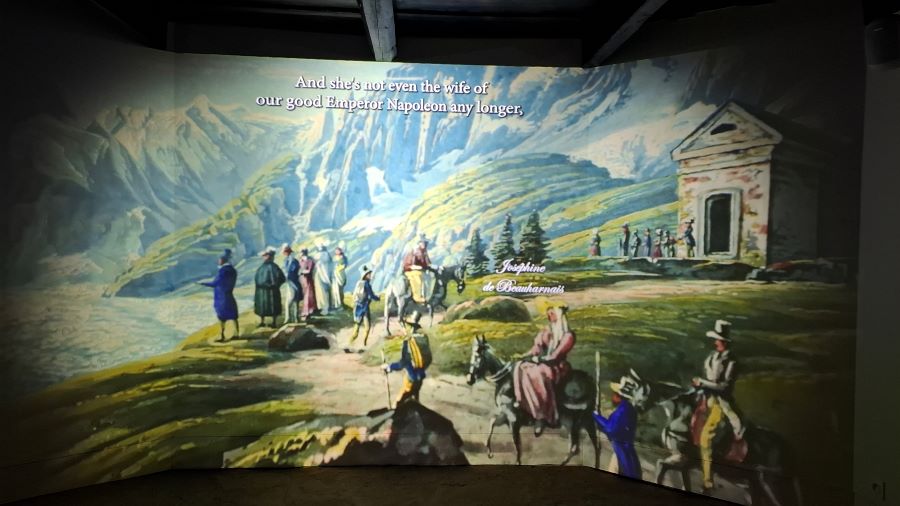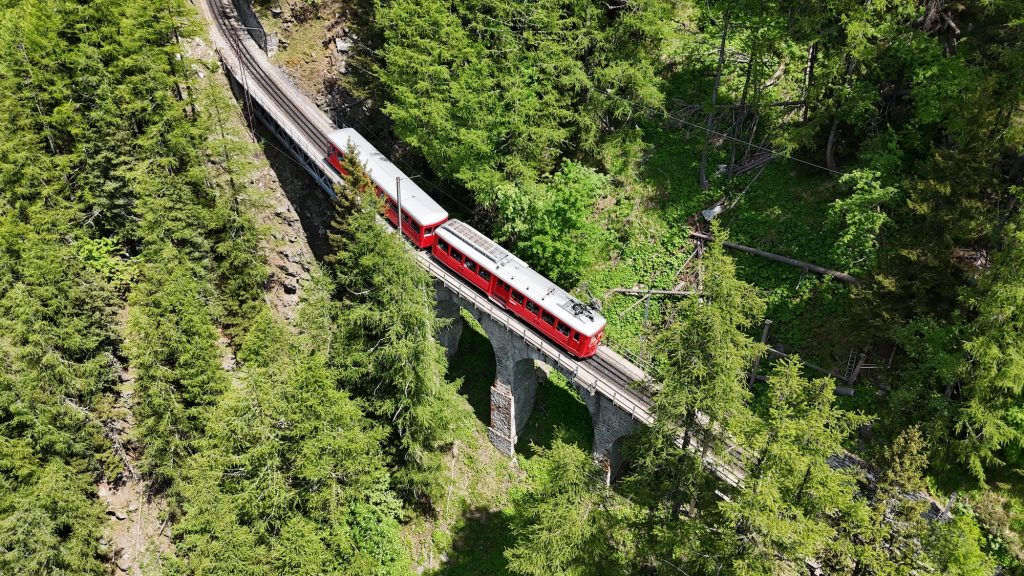The history of the Train du Montenvers in Chamonix
The Train du Montenvers, emblematic of the Chamonix valley, is a real technical and historical feat. It connects the town of Chamonix with the site of Montenvers and the Mer de Glace, one of the most visited natural sites in the French Alps. Its history is closely linked to the development of Alpine tourism and the technological advances of the time.

At the origins: the attraction of the Mer de Glace
Made famous following the visit of the British Windham and Pockocke in 1741, the Mer de Glace quickly became a must-see excursion in the Chamonix valley. In one of the first Swiss tourist guides from 1793, we can read that “Anyone who comes to Chamonix and does not make the excursion to Montenvers has missed the goal of his trip”. Once accessible on the back of a mule, this site attracted the most famous personalities of their time: from William Turner (1801), to François-René de Chateaubriand (1805), George Byron (1816) and Mary Shelley (1816), Victor Hugo (1825), Alexandre Dumas (1832), Charles Dickens (1846) or Louis Pasteur (1860), to name but a few on the long list of eminent visitors.
With the development of tourism, inspired by the writings of naturalists and the works of Romantic painters, the demand for easy access to this spectacular site has continued to grow.
The birth of the railway project (1902-1909)
In 1877, the historian, geographer and great mountaineering enthusiast Charles Durier thought that the mule was very cute, but it didn’t move very fast! Why not mechanize the ascent by equipping the Montenvers with a cogwheel railway? In the midst of the industrialisation of the country, the idea gained ground and interested a group of investors who submitted a concession application in 1892 to the General Council of Haute-Savoie.
Prefect Masclet opened, by decree of January 8, 1893, what would be called a public utility inquiry. Several hundred Chamonix residents came to express their disagreement, but finally, in 1897, the request for a concession was validated.
1902
The first plans are drawn, but work does not begin until 1906. The project was ambitious: a cogwheel railway, making it possible to climb steep slopes and overcome the topographical challenges imposed by the Alpine massif.
1906
Work on the Montenvers railway began in May 1906.
The construction site mobilized a workforce mainly composed of Italian workers, especially from the Valle d’Aosta, but also of local workers, including muleteers affected by the future disappearance of their activity. On average, 200 to 250 men participated in the construction, occupying various roles: diggers, miners, masons, blacksmiths, porters and labourers. To avoid long journeys at altitude, barracks were set up near the route,
The transport of materials and tools, such as cement, lime, wood or food, was carried out using mules
During the winter break, efforts were concentrated on Chamonix, where the location of the departure station, the depot and the maintenance workshops were defined. Located to the east of the PLM station, the new station required a footbridge to connect the two infrastructures and facilitate the movement of passengers.
Cliquez sur les images pour les agrandir
1908
On 3 August 1908, the company obtained the agreement in principle from the administration for an opening to the temporary terminus, at a place called La Filliaz. The end of the ascent was done on foot and on the back of mules, by a path leading visitor to the Montenvers.
On November 7, 1908, the first convoy of works reached the upper station of Montenvers after the viaducts of the Bois and Montenvers had been finalized and tested in the autumn by 3 steam locomotives.
During the ten weeks of operation to the temporary terminus, 24,000 people had been transported!
Cliquez sur les images pour les agrandir
1909
The train reaches the Montenvers ! The operating season began around Pentecost, either at the end of May or beginning of June, with a service reduced to three round trips per day and a travel time of about 55 minutes.
Between the beginning of July and mid-September, the frequency increased to five daily departures from Chamonix: at 6:00 am, 8:10 am and 10:00 am in the morning, as well as at 2:00 pm and 4:30 pm in the afternoon. The first departure was only guaranteed if at least twenty passengers had registered the previous evening.
1910
On 7 September 1910, on the occasion of the fiftieth anniversary of the annexation of Savoy to France, President Armand Fallières visited Chamonix. Received by the local authorities and the company of guides, they inaugurated the town hall before reaching the cogwheel railway station. At 2 p.m., a special train took the procession to Montenvers from where the president admired the Mer de Glace,
The 1910 season allowed 44,707 people to be transported.
Cliquez sur les images pour les agrandir
The interwar period, and the post-war period
With the resumption of tourism after the war, the Mer de Glace regained its status as the flagship attraction of the Chamonix valley. Every day during the months of July and August, several thousand visitors flocked to the Montenvers railway station.
However, despite efficient management and rigorous maintenance of the rolling stock, the operator realised that it would be impossible to continue to absorb such a volume of passengers without undertaking a thorough modernisation of the line. The latter, practically unchanged since its inauguration forty years earlier, no longer met the requirements of an ever-increasing number of visitors.
Also noteworthy is the creation of the 1st ice cave in 1946 by Mr. Georges Claret via a municipal concession. An attraction aimed at renewing the attraction of the Mer de Glace, whose level was (already) falling year after year.
Cliquez sur les images pour les agrandir
1953 -1954
The line is electrified, replacing steam locomotives with electric locomotives, a major innovation that improves efficiency and reduces environmental impact. Schweizerische Lokomotiv- und Maschinenfabrik (SLM) in Winterthur.
In the spring of 1954, the work was completed but the new trains had not yet been delivered. The operation therefore began again in steam action. The four railcars and two trailers were put into operation in July and August, reducing travel time from 50 to 20 minutes.
Cliquez sur les images pour les agrandir
1955-1971
Traffic grew steadily to reach more than 730,000 visitors in 1971!
But, faced with the retreat of the glacier, developments are being made to maintain the attractiveness of the site. In 1960, a cable car was installed to allow visitors to descend to the surface of the Mer de Glace. This infrastructure, modernised by a gondola lift in 1988 and replaced in 2024 by a more modern gondola lift with access closer to the glacier, becomes an essential complement to the Train du Montenvers.
To cope with the increase in the number of passengers, the company acquired its first diesel locomotive in 1967. Montenvers was first accessed in winter on 31 December 1967!
From the 70s to the 90s
The traffic continued to grow and crowned the success of the Montenvers railway.
A further increase in the fleet continued with the commissioning in the spring of 1972 of 2 new diesel locomotives! This brings the total number of locomotives to 8.
The record number of 22,894 daily passengers was reached on August 14, 1975! As well as the absolute record of 162 trains (81 return journeys) was set on August 14, 1975! That same year, the company had more than 50 employees.
In 1979, a sixth electric locomotive was put into service. The company now has 9 locomotives!
In 1990, the absolute record for passengers transported over the year was achieved with 1,008,305 passengers having taken the train!
From the 90s to today
In the early 1990s, priority was given to securing the avalanche paths to allow the line to operate in all seasons. This vast project, spread over six years, considerably strengthened the protection of the railway route. A total of 597 metres of track were protected from avalanches, ensuring better safety for users.
In 1993-1994 a regular annual service was set up, allowing the attendance to be spread over the whole year and offered an additional service to skiers doing the Vallée Blanche.
From 2011 to 2024, renewal of all the rails, rack and pinion and switches on the 5,140 m of the line.
This development programme reflects the desire to preserve and modernise this line, which has been listed as a historical heritage site since 1985, testifying to its cultural and tourist importance.
An icon of today
Since 1 November 2024, the Department of Haute-Savoie has taken over the operation of the Montenvers train via a public service company that ensures the quality of the public service and a controlled commercial policy, while continuing to maintain the site and the equipment.
Today, the Train du Montenvers transports around 700,000 visitors each year. It remains one of the symbols of mountain tourism, combining heritage, technology and respect for the environment.
The Train du Montenvers is much more than just a means of transport. It embodies the history of a region, human ingenuity in the face of nature, and the unbreakable bond between man and the mountains. It continues to fascinate generations, testifying to the importance of preserving these unique places for centuries to come.
Cliquez sur les images pour les agrandir
And tomorrow…
The fleet of vehicles (6 locomotives and 6 trailers), many of which are over 70 years old, will be renewed with new-generation electric trains, bringing better comfort to users and reducing the electricity consumption of the infrastructure.
The Montenvers site, which has become an emblematic witness to the effects of climate change, is continuing its redevelopment, which began in 2020, in order to improve the reception of visitors and to reinforce an environmental awareness message around a climate interpretation centre project.
Source: “Le train de la Mer de Glace” published by Cabri – www.cabri.fr
